|
  


short-grain sticky rice, bamboo tubes, banana
leaves, cotton string

1. Wash
the sticky rice and soak it in clean water
overnight. The sticky rice must absorb water in
order to taste good.
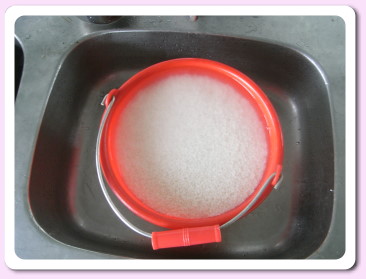
2. Cut
the makino bamboo poles we brought down from the
mountains into segments, wash, and drain dry. When
we asked Uncle He of the community to bring us up
into the mountains for the bamboo, Uncle He told us
that the makino bamboo used for making bamboo rice
is usually around a year old, with a diameter of
around 3 to 4 centimeters.
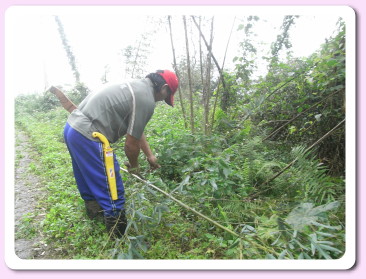 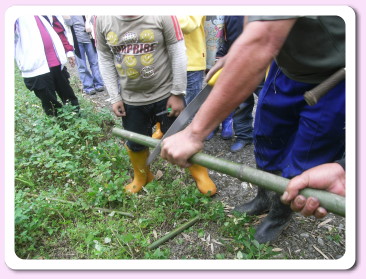

3. Stuff the soaked sticky rice
into the bamboo tubes until about nine tenths full,
add a little water, then seal the open end with
banana leaves and cotton string. Nowadays, people
sometimes choose to use heat-resistant bags and
elastic bands because it is more convenient.
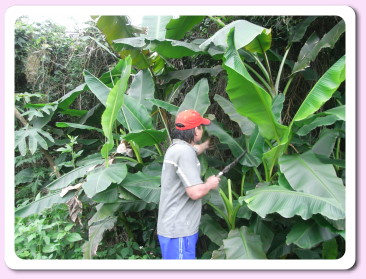 
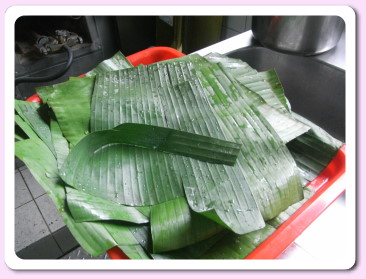 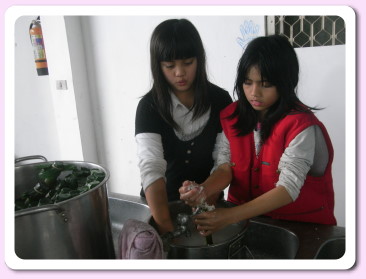
4. Neatly
arrange the bamboo rice tubes into a large pot, fill
the pot up to about nine tenths full, then put the
lid on, let it cook for one to two hours, and there
you have delicious bamboo rice.
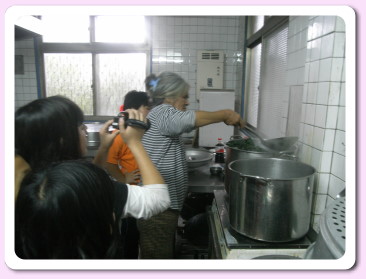 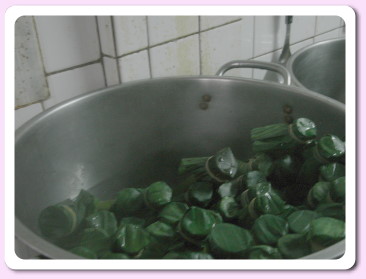
5. How do you eat the fragrant
sticky rice that’s encased within the bamboo tube?
There’s a trick to that too! Ms. Li-lian Wang taught
us to hold the open end of the tube, knock the other
end with the closed knot on the ground, and it will
naturally break into two halves, allowing you to
access the rice inside. Ms. Li-Lian Wang also told
us not to remove the piece of banana leaf that’s
wrapped around the open end of the tube, that way
the contents of the tube will not fall out.
 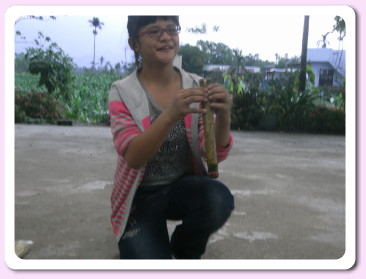
6. The bamboo
rice that we’ve extricated from the tube is covered
with a thin film of bamboo substance, and is
non-sticky and easy to hold. The rice smells light
fragrant of bamboo, and if you chew it slowly in
your mouth, you can taste the sweetness of both the
bamboo and the rice. Bamboo rice can be easily
carried around, and provided a good filling meal
just by itself or as an accompaniment for the people
who used to hunt or work high up in the mountains.[up]
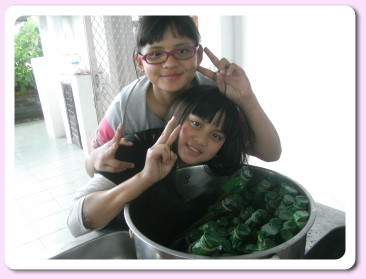

1.
How much
bamboo stalk do you need for making bamboo rice?
What kind of bamboo do you use? How long do the
tubes need to be? How do you cut the bamboo stalks?
If you want some bamboo rice, the
first thing you have to do is get ready some tubes
of bamboo. It depends on how many people you need to
feed, but you can always prepare a little extra, in
case some people ask for more.
We mostly use the makino bamboo,
try to choose bamboo stalks that are neither too
thick nor too thin. The bamboo have knots at
different places in their stalks, so the tubes will
turn out to have different lengths. You must cut the
bamboo so that one end is open, while the other is
closed up by the knot inside, then you can fill the
tube up from the open end.
2.
How many
kilograms of rice do you need for bamboo rice? What
kind of rice do you use? How do you prepare the rice
for cooking?
The amount of rice you need also
depends on how many people you’re cooking for, but 3
liters of rice can be made into roughly 50 tubes.
Most bamboo rice is made with sticky rice. You must
wash and then soak the rice for at least 4 hours
before cooking it.
3.
What kind
of leaf do you use? Do you need to prepare the
leaves in advance? (e.g. soaking)
Traditionally, we use banana
leaves, its main purpose is to wrap up the open end
of the bamboo tube, although nowadays we don’t use
leaves much anymore, but use small plastic bags
instead.
The leaves must be washed,
blanched, then cut into pieces just large enough to
cover the open end of the tubes (around 5cmx5cm).
4.
What other
details do you need to watch out for when cooking
bamboo rice? Do you need to season it?
Traditionally, we stuff the tubes
with rice using our hands, because it’s faster that
way, but if you’re not in a hurry, you can work with
a spoon. Nowadays we usually cook the bamboo rice
directly because it’s easier this way, the bamboo is
so thick that if we use the steaming method, it
would take much longer for the rice to cook through.
When cooking bamboo rice, you need to add water to
about eight tenths the height of the tubes, be
carefully not to submerge the tubes. If in the
cooking process the water evaporates, add water
accordingly.
5.
When do you
eat bamboo rice? Are there any people who are not
allowed to eat it?
The way to eat bamboo rice is to
knock the knotted end on the ground several times
until it splits, then break the bamboo open and eat
the rice inside.
Traditionally, bamboo rice is
eaten at festivals, rituals, or when hunters go
hunting in the mountains, and is mostly eaten at
lunchtime. Nowadays, you can make it and eat it at
festivals or any other time you like. There are no
restrictions as to who can eat bamboo rice or not,
it’s a common dish, and anyone who feels like it may
have some.
6.
What
is the origin of bamboo rice?
In the earlier days, when us
Truku had to hunt in the mountains, the women of our
tribe came up with the idea of carrying rice in
bamboo tubes, because back then we had no bento
boxes to use. Bamboo rice is not only easy to carry
but convenient, you need only to break it open to
get at your meal. [up]

|

Yu-hsuan Wang |
I think what makes
bamboo rice unique compared with other
foods is its appearance. Most rice is
eaten from a bowl, but bamboo rice is
contained in bamboo tubes. Although it
doesn’t have a distinctive smell, but
the texture is different and doesn’t
taste like anything else. There is a
thin film around the rice, so that it
tastes soft and sticky on the inside,
but a little crunchy and non-sticky on
the outside. Out of all the bamboo rice
I have tasted, I prefer the
traditionally basic flavor with no
seasonings best of all. |
|

Ting-hsuan
Kao |
he bamboo rice we
made today is the result of our joint
efforts, please cherish your blessings.
Remember that “every grain of rice comes
from hard work,” and eat up all the
bamboo rice with grateful feelings. |
|

Yan-you
Wu |
I’d like to express my thanks to
Uncle He, because he not only brought us up the
mountains to harvest bamboo and saw them into tubes,
but got wounded and bled in the process of cutting
down the bamboo for us. I’d like to tell him we are
grateful, and hope his hand heals very soon.[up] |

Reference:
1. 2011.4.5, Sinbaiyang Cultural Information Club Experimental
Course Process (Bamboo Rice)
2. Jianching Village, Wanrong Township, Hualien
County. Interviewee: Ms. Li-lan Wang, Ms. Xiu-shu Wen, Date of
Interview: 2011.5.26
|

